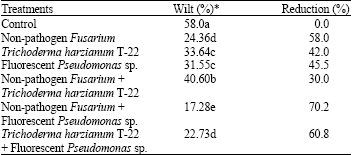Research Article
Control of Fusarium Wilt of Tomato by Combination of Fluorescent Pseudomonas, Non-pathogen Fusarium and Trichoderma harzianum T-22 in Greenhouse Conditions
Fethiye AS.M.K. Vocational School, University of Mugla, Fethiye, Mugla, Turkey
Murat Dikilitas
Department of Plant Protection, University of Harran, Sanliurfa, Turkey









